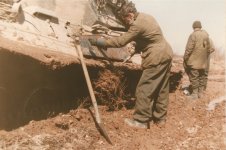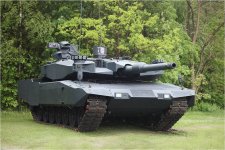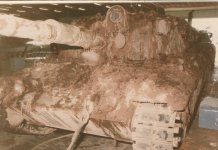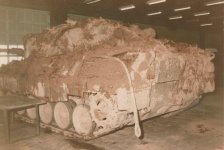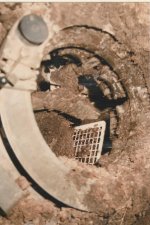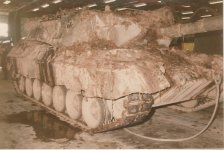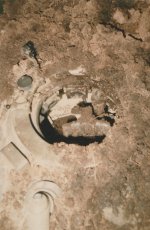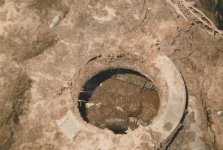George Wallace
Army.ca Dinosaur
- Reaction score
- 130
- Points
- 710
Reproduced under the Fair Dealings provisions of the Copyright Act.
Why Can’t Tanks be Larger? Rheinmetall’s 130mm Gun and the Future of MBTs
Posted By: Alex Hempel June 25, 2016
Rheinmetall Defence
German arms manufacturer Rheinmetall recently unveiled its new highly-anticipated 130mm cannon design for use on next-generation tanks. Rheinmetall’s 120mm tank gun is the most widely fielded non-Russian tank gun and holds a virtual monopoly on NATO and Western-allied tank armaments; currently, all Western main battle tanks (MBTs) are armed with either smoothbore (most countries) or rifled (UK) 120mm Rheinmetall cannons. There are two variants, the L/44 and L/55, which have barrels of different lengths. In many cases, the cannons are license-produced, such as the L/44 M256A1 cannons used on M1A1 and M1A2 Abrams tanks, which are manufactured at the Watervliet Arsenal in New York.

An M1A2 SEP V2 Abrams tank, armed with a license-produced L/44 120mm gun.
Intended for use in next-generation main battle tanks, the new gun 130mm comes at a time when tank armor is becoming increasingly difficult to penetrate. Innovations such as explosive reactive armor, high-end composites, and active protection systems oftentimes mitigate if not completely nullify the effects of anti-tank weapons such as kinetic (KE) sabot rounds and explosively formed penetrator warheads. Russia, in particular, fields Kontact-series explosive reactive armor, which is designed to, among other things, reduce the effectiveness of the of KE rounds fired from 120mm tank cannons. Equipped with Kontact ERA, many newer Russian tanks have armor levels which approach that of advanced NATO tanks and inhibit the penetration of all but the highest-power anti-tank weapons.

This T-72 tank is covered in older ERA bricks. Newer ERA such as the Kontakt-5 fitted to some T-90 tanks is even more effective.
It is in this context that the 130mm gun becomes appealing. Because increases in bore diameter are not proportional to increases in propellant volume, the modest 10mm increase in bore size actually yields a massive 50% increase in kinetic energy over the standard 120mm round. This increase ensures that the 130mm gun will remain potent for some time, whereas the ability of the 120mm gun to counter future advances in protection is less clear.
However, it remains unseen whether or not the 130mm gun will eventually achieve the ubiquity of its predecessor. Upping the caliber of tank cannons to increase kinetic energy is far from a novel idea. In fact, trials during the Cold War were undertaken with even larger 140mm guns. However, a number of problems precluded the introduction of the 140mm gun, and it is easy to see how these same issues may manifest themselves in tanks with the 130mm as well.

This Abrams-based testbed is fitted with a massive 140mm cannon. The idea ended up being abandoned, as issues effectively integrating such a large gun into the Abrams platform arose.
The biggest issue that will face engineers trying to incorporate the 130mm gun is its increased weight and dimensions. The 130mm is heavier, at 3.5 tons, than the 3 ton 120mm gun. Housing the slightly enlarged 130mm as well as its correspondingly enlarged equipment will necessitate a redesigned turret, according to Rheinmetall engineers. This could be problematic because many NATO tanks are already behemoths. The American M1A2 SEP V2 Abrams weighs in at a staggering 69 tons, a weight similar to the largest heavy tank destroyers of World War II.
At this point, it is worthwhile to examine the role of the MBT on the battlefield. Unlike the highly specialized 70-ton gun carriages of World War II, main battle tanks are not slow breaching vehicles. Rather, they are all-purpose armor intended to fill a variety of roles, from engaging other tanks to exploiting maneuver opportunities and bolstering infantry operations. Thus, the “main” in “main battle tank” reflects that MBTs are intended to be versatile, which requires speed and mobility. Further increases in weight could threaten this mobility significantly.
Most obviously, there is the issue of operational mobility, or the ability of the tank to move to the battlefield under its own power. One factor affecting operational mobility is ground pressure per unit area, usually expressed in psi. This figure is obtained by dividing the tank’s weight by the surface area of its tracks’ contact patch. Obviously, a higher weight per unit area results in the tank being more prone to sinkage into soft ground as well as more rapid wearing of road surfaces. If the weight of a 130mm-armed tank were to be increased but the track size was to remain the same, problems associated with higher ground pressure would manifest.
Alternatively, when working with added weight of the 130mm, tank engineers could work to increase the track surface area proportionally to the weight increase and thus achieve a low ground pressure. However, tanks with tracks of a larger length and width have their own issues. The larger the vehicle, the more difficult it is to fit through passageways and urban streets. The tank could also reach a size that makes it unable to traverse smaller roads or passes, all of which would be detrimental to mobility. No matter the track size or ground pressure, overall weight also plays a factor: excessively heavy tanks may be unable to pass over small bridges, which can be an issue when there are many rivers in the area of operations.

Airmen load a M1A1 tank onto a C-5M Super Galaxy airlifter.
Also important is the effect of weight on strategic mobility, which is the ability to move the tank over long distances, ie: get it to the battlefield from wherever it is based or stored. In this realm, ground pressure is unimportant, as the tank itself generally does not have to move over soft ground during transport. Increases in overall weight and size, however, are critical. Tanks generally do not move unassisted over long distances, because they have atrocious fuel economy and the wear incurred by long-distance travel is expensive. And, of course, if there is a large water body such as a sea or ocean, boats are a necessity. Strategic airlifters such as the C-5 can also move tanks very rapidly, but this is by far the most expensive option and is only available to countries that possess such aircraft. Tanks are usually moved over land by a prime mover, whether it be a train or a truck, for the aforementioned reasons. Trains and trucks have payload size limits, namely the width of roads and the maximum width of a train car as permitted by rail infrastructure. Airlifters have similar limits to their maximum cargo dimensions and weight. Thus, the limits of tank size are not only established by battlefield needs but also logistical ones; for economic as well as tactical reasons, all tanks produced must fit onto some sort of a strategic transport. Any tank design which cannot fit onto a train or truck is essentially doomed.
So, in conclusion, tank designers will have to avoid significant increases in weight and size when producing new tanks with the 130mm cannon. Increases of more than a few ton over current-gen tanks would likely be unacceptable; and weight increases could be wrought on not only by the inclusion of a new gun but also of new protective systems, drive technologies, etc. Because of this, next-gen tanks will need to either miniaturize some components to free up space or design the next-generation components to be smaller the same size as their current-gen counterparts.
Take, for example, the turret. Engineers could theoretically design a 130mm turret that is the same weight as the current 120mm one while still increasing protection and performance, but this would require reducing the weight and size of some systems to accommodate for the increase in the weights of the gun and its equipment. Given advances in electronics and lightweight materials, this is within the realm of possibility, but the ease of execution is not yet clear. And, if we look at past trends in tank warfare as well as the trajectory of aircraft and ship weights, it seems a tall task. Indeed, American planes, tanks, and ships all tend to increase in weight as time passes. Whether tank designers can slow, halt, or even reverse this trend while still incorporating the larger 130mm gun remains to be seen; if engineers fail to do so, the proposition of widespread 130mm adoption will be significantly less attractive, especially for nations who need their tanks to weigh less than 70 tons.
The issue of increased cartridge weight is another important aspect. The cartridge is the shell and its propellant, are loaded into the breech of the gun the gun before it can fire. The 130mm cartridges are 30kg, whereas the 120mm cartridges are 21kg. Because of this significant 9kg increase in weight, Rheinmetall engineers believe that the 130mm cartridges must be autoloaded. Autoloading is the process by which mechanical means are used to reload the gun, as opposed to manual loading, in which a human loader performs the task.

A Russian serviceman loads trays into a T-72 autoloader.
At this point, some readers may be wondering: why would autoloading be detrimental? After all, machines tend to perform tasks faster and more precisely than humans do. However, in terms of tank gun loading, there are actually benefits conferred by using a human loader. Counterintuitively, a well-trained human loader can potentially load rounds more quickly than current autoloaders, if conditions are ideal. And, while machine loading may sound precise and reliable, autoloaders are highly complex and thus tend to break down or fail when damaged, which can be catastrophic when under fire. Many tank commanders also like having the extra crewman for a number of reasons, including the increased manpower for odd tasks and the redundancy in case of casualties. Because of the numerous benefits of manual loading, it is the method preferred by the majority of NATO countries, including military heavyweights such as the US and Germany.
Autoloaders do have some advantages, the largest being their smaller size relative to a human loader (or, more precisely, the space required to house a human loader in the turret). The usage of an autoloader is one of the reasons that Soviet tanks such as the T-72 have a lower profile than manually loaded Western tanks, thus presenting a smaller target. This decrease in turret volume afforded by autoloaders could play a role in compensating for the increased size and weight of the 130mm gun, assuming the necessary autoloader is still smaller and lighter than a human loader and its facilities. Another advantage afforded by the autoloader is its indifference to fatigue and bumpy terrain (human loaders can be jostled around if the tank is careening through ditches or over bumps). It is also possible that engineers could produce an autoloader that is faster and more reliable than a human loader, but this has yet to be achieved.
In conclusion, there are barriers to introducing the 130mm tank cannon. Not only will it be difficult to stop weight and size increases from impacting mobility, but it will also require some NATO members to adopt autoloaders, which they have opposed for decades. However, the 50% increase in kinetic energy is quite a dividend and could make all the engineering effort well worth it. If Russian tank armor and defenses progress much further, adoption of the 130mm may be the only way forward for Western tank armaments. In any case, it will be around a decade before the 130mm gun is ready for mass production and probably even longer before a tank is designed around it, so the best that can be done is to wait and see, as the progression of armor and resulting changes in NATO penetration requirements will not be revealed for some time.



